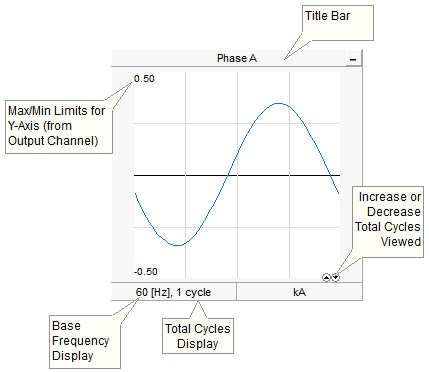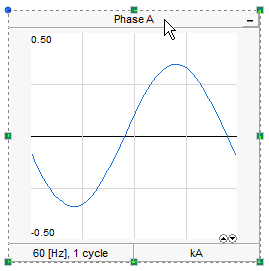
Moving and Re-sizing an Oscilloscope
An Oscilloscope is a special runtime object that is used to mimic the triggering effects of a real-world oscilloscope on a time varying, cyclical signal like an AC voltage or current. Given a base frequency, the oscilloscope will follow the signal during a simulation (like a moving window), refreshing its display at the rate given by the base frequency. This gives the illusion that the oscilloscope is transfixed on the signals being displayed, resulting in a triggering effect.

Oscilloscopes are special objects that cannot be added directly from the tool bar. Each object is directly linked with a curve from a single Output Channel component. The oscilloscope supports array signals – that is curves containing more than a single trace. The following section describes how to prepare data signals for display in the oscilloscope.
To add an oscilloscope, right-click on an Output Channel component within the Schematic canvas and select Graphs/Meters/Controls | Add as Oscilloscope. The oscilloscope will appear attached to the mouse pointer. Move the pointer to wherever you wish the new meter to reside and then left-click to place it on the Schematic canvas.
To move an oscilloscope, move the mouse pointer over the title bar and then left-click and hold. Drag the meter to where it is to be placed and release the mouse button.
To re-size, move the mouse pointer over the title bar and left-click to select the meter. Grips should then appear around the outer edge as shown below.

Move the mouse pointer over one of the grips. Left-click, hold and drag the pointer to re-size.
Right-click over the oscilloscope and select Cut or Copy respectively. Once an oscilloscope has been cut or copied it may then be pasted to another location in the project.
Cut or copy an oscilloscope as described above. Right-click over a blank area of the project page in Circuit view and select Paste. A scope may be pasted multiple times.
The entire oscilloscope display can be copied to the Windows clipboard in either meta-file (*.wmf) or bitmap (*.bmp) format. Right-click over the scope title bar and select Copy as Bitmap or Copy as Meta-File. Go to your report document and paste the image.
You can navigate directly to the associated Output Channel component by selecting this option. Right-click over the oscilloscope and select Navigate to Channel: PSCAD will automatically find the output channel and highlight it.
The y-axis limits of the oscilloscope are set in the corresponding Output Channel Properties dialog. This dialog may be accessed directly from the scope by right-clicking over the device title bar and selecting Channel Settings....
The total displayed cycles can be adjusted in the status bar near the bottom of the oscilloscope: Left-click the corresponding button on the display selector, where the buttons represent increase and decrease respectively. This same operation can be performed by right-clicking over the device title bar and selecting either Increase One Cycle or Decrease One Cycle.
